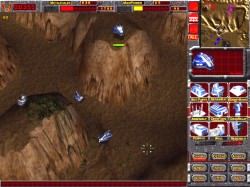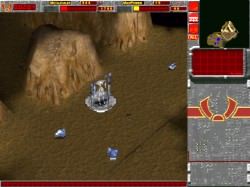| Metal Fatigue Interview
Courtesy of Psygnosis |
||||
|
Q: What is distinctive and special about the single-player and multiplayer modes in the game? There are really three main features we feel set us apart from other RTS games. The first is the configurable Combots. They are made up of a Torso, a set of Legs, and Two Arms. Each side in the game has unique parts, and during combat parts can be amputated or blown off. You can then pick up those parts and use them for yourself, sell them, or even research them and start producing your version of it. We really like the idea that most of the new technology you get during a mission comes from taking it during combat, rather than who can build down the tech-tree the fastest. The second feature is the three playfield layers. The game is taking place simultaneously on three battlefields, the Surface (which is what every RTS player is familiar with), Orbit (where flying units rule, and solar panels can collect energy indefinitely), and the Underground (where you can tunnel around to discover hidden energy sources, or even tunnel under your enemy and launch a surprise attack). Adding these two additional battlefields greatly increases the kinds of strategies a player can use. Another cool feature is our Pre-Build phase. From a story standpoint, at the beginning of each mission you are travelling to the planet where your mission will take place. During that time you can "pre plan" your initial base, and build up your initial forces as you see fit for the mission at hand. Since you're just planning, you can build things instantly, and remove them if you decide you don't want them. Once you're ready, you let the game know and the mission begins with that force ready to roll. This alleviates a lot of the early game tedium you get from having to always build that same initial base, and also lets you play around with various opening strategies. To me this feature really sets our multiplayer apart - there are so many different ways that people can come out of the starting gate. It's really cool to see the different combinations of starting forces people have, and the way people try to maximize every last pre-build dollar they can spend.

In Multiplayer we have a timer on the pre-build phase, which can make it very fun and frantic as you race against the clock to try and get the best starting force. Of course you can turn the timer off if you don't want to deal with that, and in single player you can take as much time as you like. Note that not all missions have a pre-build phase. Those are the big three. Of course there are plenty of other smaller features that we've put in: for example in a single player campaign you are awarded bonuses for completing missions, and those bonuses can be used to upgrade your robot crews, and improve your structures and vehicles. Q: What distinguishes the artificial intelligence in this game from most of what is out there in real-time strategy games? How predictable will computer-controlled enemy moves be to somebody who plays the game a lot? Is there really learning over time that takes place among these computerized adversaries? I'm a little hesitant to gloat about how great our AI is because people will cry foul the moment they see it do something even remotely "artificial". This is a general rule for me, not just concerning Metal Fatigue. So, I'll just explain some of the more tangible features, and let gamers decide! |
 Our AI is created by Mark Baldwin, a long time war game and AI guru. One of the biggest distinguishing features is that we have various AI "Generals" that you take on. What this means is that you're not always playing against the same AI personality. In single player, on one mission we may pit you against an AI that focuses a bit more on underground sneak attacks, while on another mission we may choose an AI that has a very aggressive attitude and, say, leans more towards an aerial strategy using planes and Combots with jetpacks. Or, we may just pick an AI general at random among a set of AI generals we've decided are particularly well-suited for that mission. There are also a lot of variable elements within these personalities, so even if you know which one you're facing, they still aren't predictable and the AI "moves" are not always the same. In Multiplayer skirmishes against the AI, we plan on letting you a choose an AI General, or Generals, to fight against or just have them randomly chosen. This is nice because if you feel that you're always getting beat by other players who use a certain style, you can practice against an AI that does the same sorts of things. There is some AI learning that occurs too. For example, if an AI squad is easily wiped out when it comes to attack you, the AI will send a larger force the next time. In some other games the AI would have continually sent the same pre-programmed force at you, and that's always bugged us. Q: Is there any opportunity for free unstructured gameplay or is everything mission-oriented? Is there time pressure involved in completing missions? The single player missions span that whole range, actually. The majority of them are rather unstructured, wipe out the enemy kind of missions, which you can do in whatever way you see fit. But we've also sprinkled in a healthy mix of other types of objectives like destroying a specific enemy structure, capturing a piece of Alien technology, and commando style missions where you start with a specific squad. Our goal was to make the missions diverse but still remain true to the genre, so as much as possible we try to avoid anything that's overly puzzle oriented. Here's an example of what I mean: In one mission there is a robot crew that has been stranded underground in hostile territory. Your mission is to land, establish a base, and fight off the enemy long enough to rescue this stranded crew (either tunnel them out or try a perilous surface escape) and return them to base. There is no set "timer" on this mission (although we use timer objectives elsewhere), but there is an implicit timer. If the player dawdles too long, eventually the AI will discover the stranded crew and kill them. Another way we add variety is to make those non-battle type objectives into secondary objectives, which are good for more upgrade points, but you don't HAVE to do them to complete the mission. Q: How crucial is 3D hardware video acceleration to the game? Are the graphics really decent without it? What is the maximum and minimum screen resolution and color depth at which the game can be run? 3D acceleration is required for the game. So, I guess you could say the graphics could really suck without a 3D accelerator (Hmmm… don't misquote me on that). The game currently runs in 16-bit color spanning resolutions from 640x480 up to 1600x1200. We may add support for 32-bit color if time permits. Q: Do you intend to support 3D sound in the game? If so, how will it enhance the gameplay? As the view in the game is from various angles above the battlefield, we don't really see 3D sound as being a big priority for us. Although I personally love it in first-person games, it doesn't deliver much value in a RTS game played from this perspective. However we do have sound decay that reflects your distance from sound sources. Go to Page Three
|
|||
|
Copyright © 1997 - 2000 COMBATSIM.COM, INC. All Rights Reserved. Last Updated June 19th, 1999 |
||||
